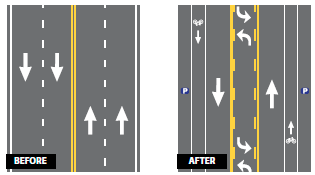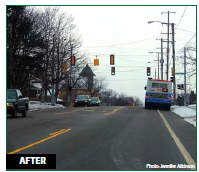ROAD DIET AND TRANSIT WORKING TOGETHER
| Objective | Features | Results |
|---|---|---|
|
|
|



BACKGROUND
In 2012, the City of Grand Rapids, Michigan, installed a Road Diet on Burton Street stretching from Division Street to Plymouth Avenue. At just over 2 miles long with a mix of residential and commercial businesses, this segment of Burton Street experiences approximately 15,000 vehicles per day and is home to several schools and a public park. In addition to buses transporting students to school, a transit route also runs along this section.
TRAFFIC CONGESTION CONCERNS
Although recent Road Diets in Grand Rapids had proved successful, there were still apprehensions when the city announced the Burton Street Road Diet conversion. Opponents were worried that traffic congestion might occur as a result of the frequent stops of school and transit buses traveling within the corridor.1 Residents in the area were also concerned about having sufficient gaps to turn onto Burton Street at stop-controlled intersections. Rick DeVries, Assistant City Engineer, was well aware of the traffic congestion concerns brought to the city's attention, "You try to balance what you're trying to do safety-wise, and quality of life, with those kinds of concerns."2
Public Opinion:3" I believe in both improving our road's safety and increasing the bike friendliness of Grand Rapids. The Burton road diet brings the best of both worlds."
A PRACTICAL COMPROMISE
The city needed a solution that addressed the concern that frequent bus stops might contribute to traffic congestion if Burton Street underwent a Road Diet. While transit stops are often equipped with bus pull-offs, transit providers in the area indicated they prefer to not remove the bus completely from the travel lane, as it interferes with their ability to merge back into mainline traffic. In response, the city's Road Diet design included the addition of a designated bicycle lane that served a dual purpose: it accommodated Burton Street bicycle traffic and provided a place for transit buses to make routine stops. Transit buses are able to utilize the bicycle lane during stops and still leave the majority of the through lane available for motorists behind the bus to use if they desire. This practical solution met the needs of the transit providers in the area while also improving the roadway for bicyclists.

To further address congestion concerns, the city optimized the traffic signal timing along the corridor, improving the progression of traffic and allowing motorists to more easily access Burton Street at stop-controlled intersections by providing gaps in traffic.
In the end, those living along Burton Street are enjoying the slower speeds and bicycle lanes the Road Diet has provided.
1 Zane McMillin, "Grand Rapids leaders make case for Burton Street 'diet' as business owners cry foul," mLIVE, January 10, 2012. Assessed March 23, 2015. Available at: http://www.mlive.com/news/grand-rapids/index.ssf/2012/01/grand_rapids_leaders_make_ case.html
2 Ibid.
3 Comment from Amy Baas on "Move forward with planned Burton Street (Grand Rapids, MI) Road Diet," an online petition posted by Joshua Leffingwell. Accessed March 23, 2015. Available at: https://www.change.org/p/bike-friendly-gr-move-forward-with-planned-burton-street-grand-rapids-mi-road-diet/reasons_for_signing
